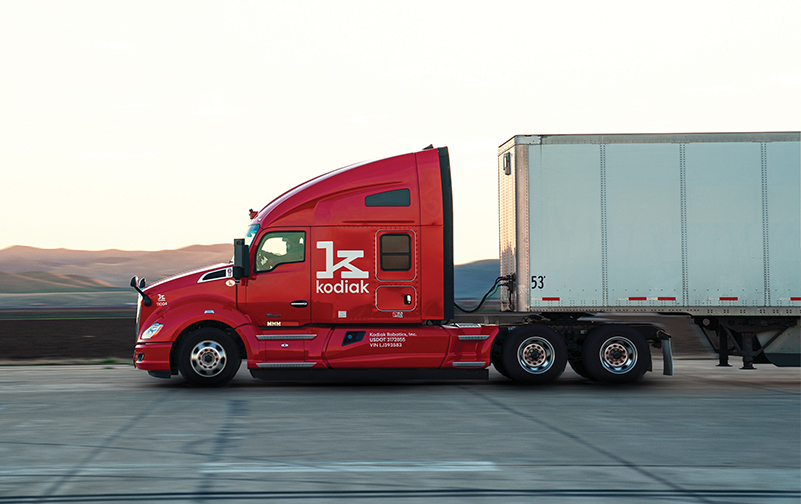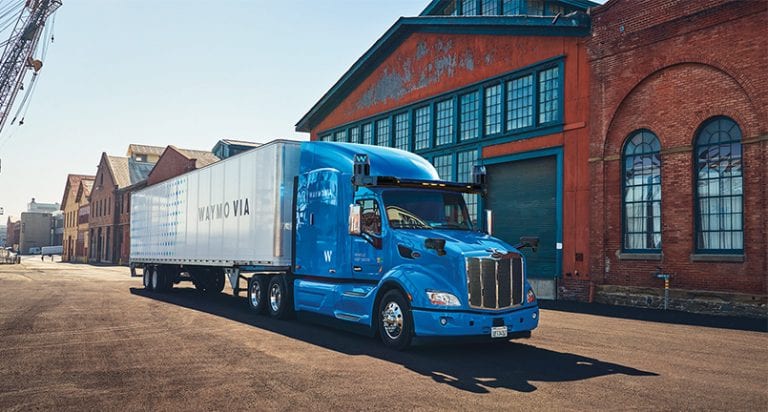The world of autonomous trucking is progressing as motor carriers such as J.B. Hunt, PGT Trucking and others, in addition to manufacturers like Bridgestone Americas, enter into partnerships with autonomous technology developers.
In mid-June, Bridgestone Americas announced a partnership with Kodiak Robotics to integrate its solutions with Kodiak’s Level 4 autonomous trucks. In addition, the companies will test future autonomous and smart tire technologies.
The move toward autonomous trucking has been coming to a head for years, with pilots and partnerships between trucking and robotics.
For Bridgestone, the drive to develop automated trucks is attributed to safety, savings and sustainability.
“Automated vehicles offer a number of benefits to commercial fleet customers and society, including safer roads with fewer unexpected incidents, and upwards of 20% savings in fuel and efficiency,” said Paolo Ferrari, chief solutions officer for Bridgestone Corp. and CEO for Bridgestone Americas. “Advancements in tire-centric technologies are critical to unlocking greater innovation in mobility, while also delivering significant sustainability benefits. This investment will enable Bridgestone and Kodiak to work together to co-develop advanced mobility solutions with speed and precision that will revolutionize commercial trucking.”

PGT Trucking hopes to address the truck driver shortage through autonomous trucking, and J.B. Hunt is launching a test run for research purposes on the company’s autonomous Class 8 trucking unit, which is powered by Waymo Driver.
“This will be one of the first opportunities for J.B. Hunt to receive data and feedback on customer freight moved with a Class 8 tractor operating at this level of autonomy,” said Craig Harper, chief sustainability officer and executive vice president at J.B. Hunt. “While we believe there will be a need for highly skilled, professional drivers for many years to come, it is important for J.B. Hunt as an industry leader to be involved early in the development of advanced autonomous technologies and driving systems to ensure that their implementation will improve efficiency while enhancing safety.”
J.B. Hunt’s test run will partner with Waymo to haul freight between facilities in Houston and Fort Worth, Texas. The transport along Interstate 45 will be completed using Level 4 autonomous driving technology, supervised by Waymo autonomous specialists to monitor the Waymo Driver’s operations throughout the runs.
According to Charlie Jatt, Waymo’s head of commercialization trucking, the Waymo Driver has to answer questions like any human driver: Where am I? What is around me? What will happen next? What should I do?
Waymo has combined detailed maps with live information sensors to detect surrounding objects and its variations.
“For each road user, our technology is able to make predictions about their movements in the future, just like a human would,” Jatt said. “Except that while a person may only be able to do this for a handful of objects, we can do this for hundreds of objects in every direction, simultaneously.”
The technology can be applied to various vehicle platforms and can be used for ride hailing, trucking and local delivery. To date, the Waymo Driver has driven more than 20 million miles autonomously on public roads and 20 billion miles in simulation.
PGT Trucking and its partnership with the human-guided autonomous truck convoying company Locomation is set to produce 1,000 autonomous relay convoy (ARC) systems over an eight-year period.
ARC systems enable a qualified driver to pilot a lead truck that’s equipped with technology augmentation while a follower truck operates in tandem through Locomation’s fully autonomous system. This allows the driver of the “follower” truck to log off and rest while the truck is in motion.
“It is a two-truck, two-driver system designed for long-haul routes typically targeting about 1,000 miles a day,” said Çetin Meriçli, co-founder and CEO of Locomation. “The way it works is around two trucks leaving the depot or the terminal. They are driven manually by the drivers in two trucks, but when they get on the interstate, the ARC system is engaged. Once the system is engaged, the driver in the lead truck remains in position and remains in control, but the second truck turns into a Level 4 autonomous truck. It fits the only job of following the leader from a closed system.”
At full commercialization, Locomation’s autonomous vehicle technology is expected to produce an estimated 30% reduction in operating cost per mile, including an 8% reduction in fuel expenses — which will remove more than 40 metric tons of carbon dioxide (CO2) from the air per convoy annually. The technology will run through certain roadways between Pittsburg and Chicago.
“My overall goal is the success of this technology and the acceptance of this technology by the industry and government regulators,” said Gregg Troian, president of PGT Trucking. “I want this to address the continuing problem of the shortage of drivers. It ties in with, from where I sit, what’s going on in this industry which is a number of different companies working on the development of autonomous vehicles. Eventually, it’s inevitable that we will have these vehicles running somewhere. Our intention at PGT is to be an early integrator and early promoter of this solution.”
Besides addressing the truck driver shortage, Troian believes autonomous trucking can bring the added benefit of lower costs through relieving the pressure of hours-of-service restrictions.
“You take the equation of a human being and limitations, and you remove that, and all of a sudden you get more productivity from an asset that contributes to lower costs,” he said.
Hannah Butler is a lover of interesting people, places, photos and the written word. Butler is a former community newspaper reporter and editor for Arkansas Tech University’s student newspaper. Butler is currently finishing up her undergraduate print journalism degree and hopes to pursue higher education. Her work has been featured in at least nine different publications.
















Time to boycott these companies pushing for attonamas trucks. this technology will destroy our economy country and way of life. with no additional safety on our roadways. with over 90% of accidents between autos and semi trucks. the autos are at fault. not to mention ciber security theft and other problems this ne technology will bring to the table. just because you can doesn’t mean you should. education for all people sharing our roadways is key to saving lives and don’t even bring up driver shortage. it’s a myth to cover up the way drivers are treated and paid it’s just a retention problem.
Man I couldn’t agree with you more I don’t see how driving an automatic reduces accidents if any thing it increases them ppl like myself and many others who drive manual u have less time to be distracted cause ur shifting